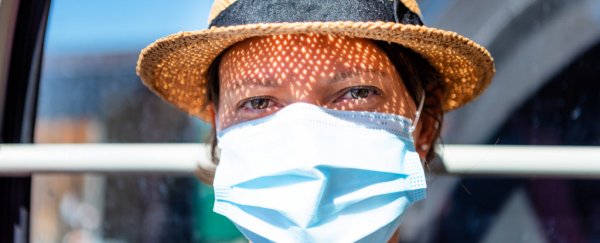A team of scientists is calling for greater research into how sunlight inactivates SARS-CoV-2 after realizing there's a glaring discrepancy between the most recent theory and experimental results.
UC Santa Barbara mechanical engineer Paolo Luzzatto-Fegiz and colleagues noticed the virus was inactivated as much as eight times faster in experiments than the most recent theoretical model predicted.
"The theory assumes that inactivation works by having UVB hit the RNA of the virus, damaging it," explained Luzzatto-Fegiz.
But the discrepancy suggests there's something more going on than that, and figuring out what this is may be helpful for managing the virus.
UV light, or the ultraviolet part of the spectrum, is easily absorbed by certain nucleic acid bases in DNA and RNA, which can cause them to bond in ways that are hard to fix.
But not all UV light is the same. Longer UV waves, called UVA, don't have quite enough energy to cause problems. It's the mid-range UVB waves in sunlight that are primarily responsible for killing microbes and putting our own cells at risk of Sun damage.
Short-wave UVC radiation has been shown to be effective against viruses such as SARS-CoV-2, even while it's still safely enveloped in human fluids.
But this type of UV doesn't usually come into contact with Earth's surface, thanks to the ozone layer.
"UVC is great for hospitals," said co-author and Oregon State University toxicologist Julie McMurry. "But in other environments – for instance, kitchens or subways – UVC would interact with the particulates to produce harmful ozone."
In July 2020, an experimental study tested the effects of UV light on SARS-CoV-2 in simulated saliva. They recorded the virus was inactivated when exposed to simulated sunlight for between 10-20 minutes.
"Natural sunlight may be effective as a disinfectant for contaminated nonporous materials," Wood and colleagues concluded in the paper.
Luzzatto-Feigiz and team compared those results with a theory about how sunlight achieved this, which was published just a month later, and saw the math didn't add up.
This study found the SARS-CoV-2 virus was three times more sensitive to the UV in sunlight than influenza A, with 90 percent of the coronavirus's particles being inactivated after just half an hour of exposure to midday sunlight in summer.
By comparison, in winter light infectious particles could remain intact for days.
Environmental calculations made by a separate team of researchers concluded the virus's RNA molecules are being photochemically damaged directly by light rays.
This is more powerfully achieved by shorter wavelengths of light, like UVC and UVB. As UVC doesn't reach Earth's surface, they based their environmental light exposure calculations on the medium-wave UVB part of the UV spectrum.
"The experimentally observed inactivation in simulated saliva is over eight times faster than would have been expected from the theory," wrote Luzzatto-Feigiz and colleagues.
"So, scientists don't yet know what's going on," Luzzatto-Fegiz said.
The researchers suspect it's possible that instead of affecting the RNA directly, long-wave UVA may be interacting with molecules in the testing medium (simulated saliva) in a way that hastens the inactivation of the virus.
Something similar is seen in wastewater treatment – where UVA reacts with other substances to create molecules that damage viruses.
If UVA can be harnessed to combat SARS-CoV-2, cheap and energy-efficient wavelength-specific light sources might be useful in augmenting air filtration systems at relatively low risk for human health.
"Our analysis points to the need for additional experiments to separately test the effects of specific light wavelengths and medium composition," Luzzatto-Fegiz concludes.
With the ability of this virus to remain suspended in the air for extended periods of time, the safest means to avoid it in countries where it's running rampant is still social distancing and wearing masks where distancing isn't possible. But it's nice to know that sunlight may be helping us out during the warmer months.
Their analysis was published in The Journal of Infectious Diseases.
